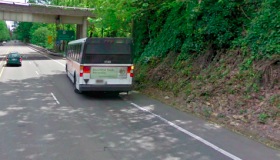
add visibility for, and respect of, this bike lane.
The Oregon Department of Transportation (ODOT) is making good on a commitment to improve the safety of people who ride bicycles on SW Barbur Blvd. Fresh off the last month’s installation of a rapid flash beacon near SW Hamilton Street (where a woman was struck and killed back in 2010), the agency is about to embark on the Barbur Boulevard Bike Improvement Project.
According to information released today, the project will include several changes aimed at providing a “better transition for bicyclists traveling southbound on Barbur Blvd at Capitol Highway.” The changes include:
- Installing a green bike lane (see concept drawing below)
- Adding bicycle signing (“Right Turn Yield to Bikes”)
- Trimming hillside vegetation to improve visibility
- Installing curb along the bike lane where it’s missing, which will help keep the bike lane clear of debris
The green-colored bike lane would be the first ever installed by ODOT. It comes after extensive experimentation of the concept by the City of Portland and other transportation agencies around the country. Most importantly, the use of green coloring won interim approval from the Federal Highway Administration back in April 2011.
Here’s the official concept drawing from ODOT…
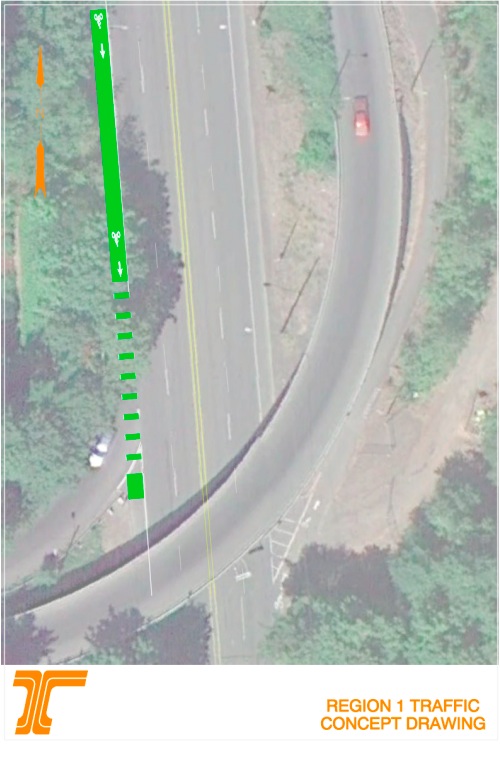
The bike improvements on Barbur emerged through a larger project to rehabilitate the Newbury and Vermont Bridges that cross over Barbur/99W. As part of that project, ODOT considered a number of larger, more comprehensive biking and walking improvements, “but they were determined to be cost-prohibitive.” The suite of improvements listed above are more immediately feasible projects. ODOT says they’re looking to implement the more long-term fixes in Metro’s Southwest Corridor Plan.
ODOT expects to finish this project this spring (weather permitting).

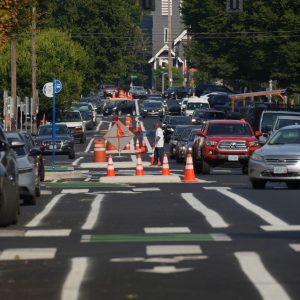
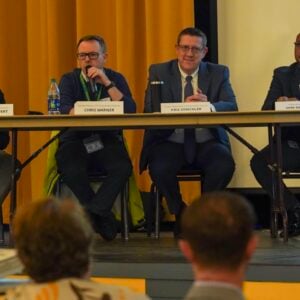

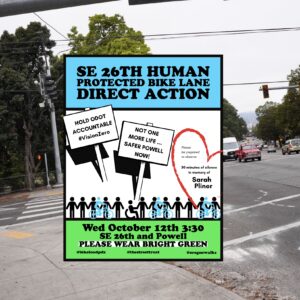
Thanks for reading.
BikePortland has served this community with independent community journalism since 2005. We rely on subscriptions from readers like you to survive. Your financial support is vital in keeping this valuable resource alive and well.
Please subscribe today to strengthen and expand our work.
If the composition is anything like the thermoplastic we now have slick surfaces to worry about…
I’ve never had a problem with thermoplastic being slippery when wet. The stuff they use has some sort of tooth added to it.
Sigh!!! – Still on the right shoulder with cars turning right. How often is ODOT willing to come out and reapply thermoplastic, this turn onto Beaverton Hillsdale is high traffic and the treatment isn’t going to last long?
Looking to the west side of Hillsdale this treatment in place already and its difficult to get excited about this so called safety improvement.
Sweet! It’s a start, and a lot, lot better than nothing at all. An entire streetscape rework would of course be preferable, but you tell me where that money is going to come from with budget cuts left, right & center.
For ODOT to be paying attention to bike & ped issues at ALL is just a big step in the right direction.
As it is now, bikes are essentially required to cross the Capital hwy on-ramp at this location when going south on Barbur. Am I right to believe that this treatment means that bikes will now have the right-of-way over vehicles turning onto capital hwy?
Adding bicycle signing (“Right Turn Yield to Bikes”)
Awesome. That is one of the areas on my commute that needs a lot of attention via improvements like this and a lot of enforcement. Step in the right direction.
This is a band-aid. The speed limit on Barbur needs to be lowered to 35, and we need a separated bike facility. 3 northbound car lanes are not needed north of Capital Highway.
Of course it’s a band-aid. That’s the thing about transportation planning. The reality is, it is often the result of hundreds and hundreds of band-aids, one after the other after the other.
It sure would be nice to have $35 million to hand, for a streetscape plan and a new cycletrack. But I don’t think that kind of money is hanging around these days.
That said, Barbur Blvd is the ONLY option for many cyclists who commute to SW Portland. I hope ODOT realize that. I tried Terwillilger & Capitol Highway once. I was trying to bike from downtown Portland out to Barbur World Market on Barbur Blvd. It took about three times as long by bike as Barbur would have done. But I was too chicken to try riding on Barbur. This is a problem.
its interesting how you did not address lowering speed limit and wrote about “streetscapes”. lowering the speed limit would cost a few thousand dollars in signage.
I drive a long this area quite often. The bikers also need to be held accountable in their actions. Some wear dark colors and still use no lights. Even though it is daytime the shade on that stretch of road makes it hard to see dark figures. bikers should be required to always use lights and wear a safety vest if they really care about safety.
Fair point. It is scary driving and coming across cyclists with no lights. I think bicycles should be sold with a basic set of lights, as standard.
In return however, I hope you would agree with me that we need every single motorist in a car on Barbur to 1)start obeying the speed limit and 2) stop yakking on their cell phones while piloting two tons of metal at 43mph. Motorists engage in unsafe, risky behaviors too, not just people on bicycles.
Safety first, as you point out. But just remember, it applies to every mode of transport!
You may need to get your eyes checked. It sounds like you may need corrective lenses.
Gosh, I thought they would have done that years ago! Always a fun ride coming back. 🙂
Barbur is my commute route most of the time, as I hate taking I-5 when I drive, and it’s really the only route from SW Durham Rd in Tigard down into NW Portland where I work when I am able to bike in. Any work on Barbur is an improvement and ODOT is to be thanked for staying aware of the many issues. I do believe the number 1 thing that should be done, however, is to lower the speed limit on the entire stretch, into and out of downtown. Far too many drivers routinely exceed the speed limit and drive at 45-50 mph, ignoring the multiple speed limit changes that are posted depending on what stretch of road we’re talking about. And, of course, the necessary follow-up enforcement.
A speed camera along this route would work absolute wonders. Particularly on the stretches where Barbur curves.
I wish they’d widen this bike lane too. Because it’s uphill, there’s a wider speed differential between cyclists and it’s a bit frustrating to get stuck behind a slower rider here since it’s a bit tricky to get around with the auto traffic.
Not that I begrudge slower riders, mind you – more power to them. It’s just that there’s not an outlet to get around them should you wish to do so unless you’re willing to look over your shoulder and jump into traffic briefly.
Kudos to ODOT for being willing to experiment for the sake of safety and the FHA for giving ODOT’s experiment the green light. Transportation wonks will surely (and should surely) nitpick the details but I think it benefits the biking community to show our support for this kind of action as it gives momentum to future projects. So… thanks!
Awesome! This is a vast improvement. I use Barbur Blvd in the summer time to go race up at Alpenrose velodrome and the section getting the marking is nearly the most dangerous part of the trip there (2nd only to going the across the two bridges just ahead).
My tactic for crossing this Barbur to Capitol Hwy offramp is to 1. See if a car understands my predicament and is slowing enough to create a gap for me to continue south onto the bridge, or 2. Ride along the fog line and signal left as if I intend to ride in the right lane – this usually startles a driver into creating a gap for me. When I cross this off-ramp after work, there is seldom a break in the traffic flow to cross the off-ramp without having to engage myself with car traffic. The ODOT improvements will be a welcome change.
Car drivers: Please remember to use your right turn signal here. I use my rear-view mirror!
I’m all in favor of ODOT starting to use modern bicycle traffic control devices.
But they need to consider the importance of making traffic control paint configurations “uniform” with the use of those in other jurisdictions.
ODOT’s design has a key difference from the colored bike lanes in Portland and elsewhere–
I call this type of area (that is being marked) a “scissors area” because it’s where the paths of cars and bikes cross at a shallow angle.
PBOT colors the scissors zone green, and doesn’t color the approach or exit green. Cars (in theory) know that the green area is their path, and that when crossing through the green area, they need to be careful not to run over any bicycles.
ODOT is coloring the scissors zone dashed green, and the approach and exit area solid green.
There are merits to this concept, where solid green represents “exclusive bicycle” and dashed green means “part bicycle, part car”. This is a logical use of color, and cars drivers may find it easier to learn to cross the bike lane in the dashed area. (Most car drivers I talk to aren’t sure if they’re supposed to cross in the green or avoid crossing in the green area).
But a seemingly random mixup of solid green vs. dashed green depending on if you’re on an ODOT road or a PBOT road is the sort of thing that the principle of uniformity is supposed to prevent.
Ted Buehler
You’re right to be concerned about the lack of consistency in colored lane applications. PBOT has been experimenting for years, and has used color for a variety of different purposes.
The ‘dashed color’ configuration seen here is gaining popularity around the country, (Long Beach, Los Angeles, San Francisco, Florida DOT) and I think it’s a good thing. I like how the dashed green conforms to existing traffic marking conventions, (signaling a merging area) and it allows a ‘solid green’ to emphasize a protected bike area, such as a bike box.
In the big picture, application of color in bike lanes is still very new so differences in application are to be expected until a standard is found. I personally hope the ‘dashed color’ wins in the end, as I think it provides a clearer, more intuitive visual language for communicating to road users.
Nick,
Good points on both accounts — “dashed = merge area” and “experimentation is important”
Thinking about it, I like this design for Barbur much better than the PBOT design. The “dashed green bike lane” does indeed conform to existing conventions of “white line = don’t cross it” and “dashed line = crossing area”
For instance, the scissors area at the east end of the Broadway Bridge would probably have better compliance if it was marked this way.
Ted Buehler
This will of course require driver education.
We can expect ZERO compliance otherwise.
q’T —
If new pavement markings are devised such that they follow the same convention as existing markings, it generally doesn’t require any driver education. It needs to be an extension of something that folks can already comprehend.
That’s why the “solid green bike line outside the scissors area, dashed green bike lane inside the scissors area” as proposed here for Barbur is so clever. It’s the same style of marking as drivers encounter crossing any bike lane anywhere in the country.
Whereas the conventional marking in Portland puts the scissors area in a place with *more* pavement marking than the adjacent bike lane areas, not less. And this is the reverse of the convention, so it does require driver education and results in driver confusion.
Ted Buehler
I can’t wait until they would update those two bridges on Barbur as I find them very dangerous to cycle across.
The other dangerous area on Barbur is where it connects with Multnomah. There is a bike lane that cuts across both a bus stop and a right hand merge onto Multnomah. They should install a green bike lane there as well.
I agree with Travis that the worst aspect of Barbur is the two bridges across the ravines. You can ride across on narrow sidewalks, but they’re precarious and shoddy. If you’re riding downhill (n’bound) you need to slow down to use them, partly negating the whole point of taking Barbur. I ride Barbur downhill 1-2x a week, and I enjoy the time savings but know I am trading off safety in doing it.
I also drive Barbur several times a week, and would ENTHUSIASTICALLY support a reduction to 35mph. That’s about the speed I drive it anyway. Everyone else seems to think Barbur is their own private freeway. Not too surprising, I guess, since it’s a parallel/alternate route to an actual freeway.
I would also support a more comprehensive traffic calming redesign of Barbur, but of course that is many millions and years away. Baby steps. The new pedestrian crossing signal is great, though it’s too bad someone had to die for it.
When I first started working in Beaverton, I often rode Barbur southbound to Capitol and then took that up to Hillsdale. Back then the bike lane wasn’t striped around the curve and drivers cut the corner even worse than they do now. Green thermoplastic should be an additional improvement (and traction shouldn’t be a major issue since it’s uphill).
I drive and ride along Barbur in probably equal measure. Any improvement on Barbur is welcome. It’s a major throughway for bikes, as some have pointed out (almost) the only route into outer SW and the ‘burbs. So YAY!
But: Barbur is a very broken concept for a road. It’s a highway — almost never at capacity, and parallel to a freeway — where a street should be. It’s overweight by at least a lane, probably two or three.
I know this is really an ODOT issue because Barbur actually IS a highway, not a street. But the insanity of maintaining so much road (4-7 lanes) for so few people (including me) is the elephant in the room.
This is one of scary parts of the highway. I rarely ride on southbound Barbur Blvd because of that part. I just toss my bike on bus and ride over there to Multnomah Village.
Way to go, ODOT!
ODOT should draw up plans to put in sidewalks to be shared between bikes and peds. If that means narrower lanes, retaining or widening to the East, so be it. Today ODOT could devote more effort in maintaining the vegetation and erosion on both sides of Barbur. High density housing on Barbur, Capital and Beaverton-Hillsdale has many commuters to PSU and downtown who could travel by bike.
I see Barbur as the strong and fearless cyclist route. I take Terwilliger. But Barbur would be a perfect candidate for a bike highway: http://www.good.is/post/good-ideas-for-cities-building-a-bike-highway as Mr Maus can surely verify.
What would it take for ODOT to be able to build bike highways?
Agreed! Everyone should send ODOT a note with a request to slow the traffic down. Anything over 25mph seems silly to me with all the pinch points that suddenly force bikes and cars to share the road.
This link should work.
http://highway.odot.state.or.us/cf/comments/comments.cfm
Also there is the Barbur Concept Plan specific to the Portland section of the Southwest Corridor. Did anyone communicate your frustrations regarding the existing conditions or your vision for the future of Barbur at any of the open houses, community working groups or through the survey? It looks like there is another community working group on April 7.
http://www.portlandonline.com/bps/index.cfm?c=55269
On the topic of green surface treatments:
Since they are infrequent and critical to safe maneuvering why hasn’t anytime considered GREEN pigmented concrete?
On a month long daily route on western TV Hwy i noticed that the bike lane was severely damaged adjacent to every bus stop. In some areas the overloaded asphalt was replaced with a more durable concrete pad.
It occured to me that there and here a green dyed concrete bike lane would have the same traction properties as normal, would be stronger to maintain smoothness when autos drive too close to the shoulder and never wear off.
Granted the cost of dying or tinting concrete a vivid green would be more than simple concrete however the costs of high tech surface treatments and their required reapplication costs may very well indicate that green concrete is the way to go.
I asked ODOT to lower the speed limit on Barber and they sent me this link. Interestingly they make the claim in quotes on the site but don’t back it up with the evidence. Nor do they include anything on the likelihood of living through an accident at any given speed.
http://www.oregon.gov/ODOT/HWY/TRAFFIC-ROADWAY/speed_zone_program.shtml
“Many people believe that lowering posted speeds will mean fewer accidents, but studies do not prove this.”
“Many people believe that lowering posted speeds will mean fewer accidents, but studies do not prove this.”
It’s all in how you spin it.
It is absolutely possible that collisions per vehicle-mile are consistent along the range of automotive speeds.
We all know, however, that higher speeds directly contribute to higher fatality rates in collisions than lower speed collisions.
In addition, higher vehicle speeds allow for more vehicles to occupy a given road segment per unit time.
Simply put: faster autos means more potential collisions each of which is more deadly.